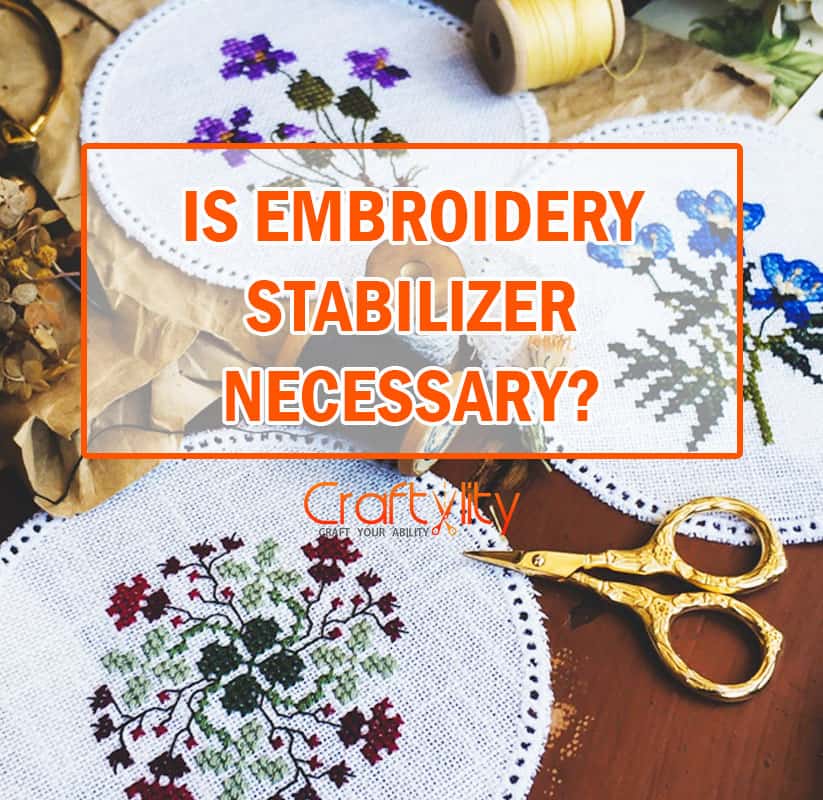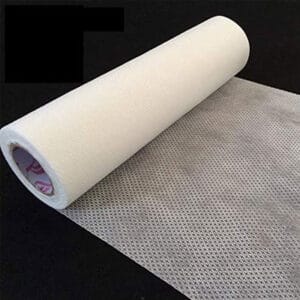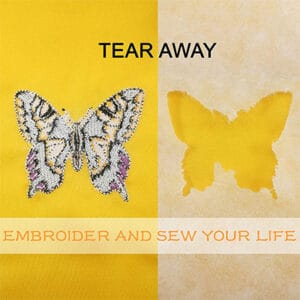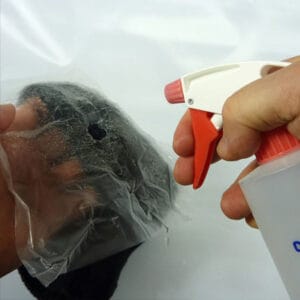A stabilizer is an important part of embroidery. Many people ask is embroidery stabilizer necessary? The answer to this question depends on the type of fabric you are using. For example, if you are using a lightweight fabric like chiffon, it may be necessary to use an embroidery stabilizer because the light fabric will show through. On the other hand, with heavier fabrics like denim or wool it may not be needed. If you’re unsure about whether or not to use it then experiment and see what works best for your project!

Table of Contents
So, is embroidery stabilizer necessary?
Stabilizer is a type of stabilizing material that can be used to keep stitches from unraveling. It is not typically necessary for embroidery, but it does come in handy if you’re embroidering on fabrics like silk or wool and there’s a chance the fabric will stretch out over time. This blog post discusses how to use stabilizer and what types are available.
What is Embroidery stabilizer?
Embroidery can be a very difficult and tedious process. There are many different types of stitches that must be done, as well as several different materials to use. Embroidery stabilizer is an important part of the embroidery process because it helps make stitching easier by providing something for the thread to grip onto without damaging your fabric or causing puckering on the other side. It also allows you to make sure your stitches stay in place while you work.
This is especially important when working with more delicate fabrics like silk chiffon or organza, but even tough fabrics like denim benefit from using stabilizer.
A stabilizer keeps the fabric from stretching and distorting your stitches. Whether you’re embroidering direct on fabric or with a hoop, a stabilizer is a key to getting nice clean lines that won’t fray at the edges.
You can buy pre-made stabilizers, but many people prefer making their own because it’s cheaper and they know what goes into them – like how much sizing to add for example if you don’t want it to shrink when washed. Here are some tips for making your own custom stabilizers without having to purchase expensive supplies!
Check out the post “What Is The Best Fabric For Hand Embroidery? 6 Best Options To Choose” this post covers the types of fabics and tips to choose right fabric for embroidery porject.
What is Embroidery stabilizer is made of?
A stabilizer is a piece of fabric that can be used to stop the surface from puckering, pilling and tearing. They’re often found on embroidery machines as well because they provide predictable stitching for hand-sewn projects or machine work alike!
The thing about this stabilizing material though? There are many different types out there — some made using natural fabrics like cotton or linen; others fashioned entirely out synthetics such as polyester blended with spandex (which gives it stretch properties). The best part? You don’t need any extra equipment besides your sewing machine itself if you want try this method yourself at home.”
Types of Embroidery Stabilizers
In this blog post, we will explore the different types of stabilizers. There are many types of stabilizers available on the market today. Choosing a type can be confusing because there are so many options to choose from.
There is an extensive variety of weights and each one goes best with certain materials, but you’re sure to find what your favorite type is!
1. Fusible Stabilizers:
A fusible is a type of stabilizer that can be used with any and all embroidery projects. It has an edge on one side of the material so it will stick out from your design when you go over stitching lines in order to create stability for those who might not know what this product does before using them.
A great feature about this particular fabric stiffener (which makes up more than half its name) is how quickly you get results; they’re ready within minutes after ironing onto your project wrong side out followed by stitching as usual–no need for waiting around on pins anymore.
2. Cut-Away Stabilizers:
This type of stabilizer is the best option for projects that will be worn and washed regularly. But, like tear-away embroidery it’s important to leave a little bit so you don’t damage your work by removing more than necessary!
Check out the following chart, this explains which crochet hook is suitable for which yarn weight:
| Cut-Away Embroidery Stabilizer | |
 |
This stabilizer is one kind of permanent stabilizers that remains on the fabric and keep it stable during and after embroidery. |
This kind can also support stitches longer-term meaning they make an excellent choice if stability or strength are key considerations when deciding between different types of stringing options in general terms – especially those which stretchier fabrics need extra reinforcement against stretching out too much over time due to their delicate nature such as satin thread or organza threads found on dresses made from polyester/cotton etcetera.
3. Tear-Away Stabilizers:
Unlike fusible stabilizers, you can see tear-away stabilizer adhesives attached to fabrics using glue.
These types of starch are for any stable woven fabric that does not stretch and come in varying weights depending on what is needed: heavier ones work best with thicker materials or higher stitch count designs while lighter versions provide better results when used for lightweight apparel pieces as well those with lower counts.
| Tear-Away Embroidery Stabilizer | |
 |
Tear away stabilizer provides temporary support for embroidery projects. Tear away embroidery stabilizer can be torn away easily yet provides adequate stability.
We recommend this product: |
To use them properly make sure your fingers stay away from the stitches – instead begin tearing at an angle towards where we want our finished cut ends up so there will be no wrong side showing!
4. Wash-Away Stabilizers:
Wash-away stabilizers are water-soluble backings that you can wash away after embroidery. They work best with fabrics such as open weave, organza, and netting which do not always need the extra help of a stabilizer like polyester or cotton because they don’t get so tangled up easily in between stitches; but there’s also other types out there too: some harder than others!
| Water Soluble Embroidery Stabilizer | |
 |
It is water soluble stabilizer, stitch and rinse tear away that is designed for light fabrics. Once the embroidery is completed the excess tears easily and the rest will dissolve in water with first wash.
We recommend this product: |
You’ll know if your chosen fabric will dissolve by its smell -inky chemical ones usually mean it won’t come off without scrubbing hard enough (and then adding softener), while citrus scents indicate something pretty mild at first touch before getting more intense over time
I recommend trimming these excess threads close once done sewing.
5. Heat-Away Stabilizers:
It’s basically like ironing your fabric before you start stitching so the threads won’t unravel after you’re finished. What makes it even better is that it doesn’t leave any residue behind on the fabric or need to be washed out of the material afterwards. Heat-away stabilizer also has a softening effect on fabrics and can help prevent stretching when sewing with knits.
This type of stabilizer either dissolves or melts away when you heat it with iron. You can use it to make your projects easier on yourself, like in the case where there are delicate fabrics that need extra support but themselves aren’t washable so much (like lace). So if you’re looking for a way to keep your stitches looking good and feeling soft, check out heat away stabilizer!
Is stabilizer the same as interfacing?
These two materials primarily have a similar purpose because they both give support to fabrics. However, interfacing and stabilizers are not the same things; there is an essential difference between them that you should know before buying these craft supplies for your next project!
Unlike most stabilizers which only stiffen locations on one side of objects without supporting from all directions as well- Interfacings provide reinforcement in multiple angles while also adding shape – usually with permanent pressability.
After you finish your work, the stabilizers are removed. However, interfacing becomes part of it and is always present in one way or another!
Can I use interfacing as a stabilizer?
The two types of fabrics, stabilizer, and interfacing are differently designed for different purposes. Stabilizers provide more structure which is usually removed after sewing whereas interfacing becomes part of the project you’re making in order to add durability while staying attached throughout its lifetime with stitches on both sides so it can’t be pulled away by anything including clothing movement or wear-and-tear from being handled roughly.
Can I use interfacing instead of stabilizers?
Stabilizers are great for embroidery projects, However, they can sometimes be tricky to work with because of their bulkiness and weight- which makes them harder to handle than regular fabrics might otherwise be! That’s where interfacing comes in handy; it has the same abilities as a stabilizer but without all those pesky issues (and gives way more support).
What is embroidery topping?
Topping is an essential part of the embroidery. Toppers can be water-soluble or heat away, and both are used to protect your stitches from disappearing on the fabric you’re stitching through by placing some sort of barrier between them so that they don’t disappear into nothingness when stitched out properly with enough time for placement before topstitching as recommended within this guidebook! You shouldn’t hoop it though – just apply securely using one method at least once it’s dry (or if applying wet) after application; either pinning around edges first carefully following guidelines given here about how much adhesive should go where.
A water-soluble topping tears away very easily, but it has the added benefit of disappearing once wet. I prefer heat-away toppings because they require direct heat from an iron or press before dissolving into nothingness!
What can i use if i don’t have embroidery stabilizer?
If you find that your stabilizers are all used up, don’t worry! There is still a way to keep the fabric in place. You can substitute it with alternative materials like thread or even tissue paper for an extra-stong hold on those stubborn areas of design
1. Fabric substitute:
Whether you’re working on lightweight fabric or a heavier one, the stabilizer substitute should be based on your material’s weight and stitch count. It is best to test them out first before using them for any project as not all alternatives will work well with certain materials
Whether its light-weighted fabrics like chiffon or heavy ones such as denim; if they match up in terms of both weight and number/length opes (i)nsteads), then any type can serve their purpose equally well:
2. Coffee filters:
You might be thinking that coffee filters are just a light, flimsy material for your sewing projects. But this DIY stabilizer will prove you wrong! It’s made from sturdy cotton and polyester fibers which means it can hold up against any rough treatment or wear-and-tear – not to mention keep dirt out of delicate areas like needle holes.
So next time something goes wrong on our end (like an errant thread), give these bad boys another go-around before giving up altogether by ironing them into place using medium heat settings in between each layer as needed until all three layers have been secured tightly together at their base with pins tacked down firmly near edges.
3. No-show mesh:
For those who want to avoid the hassle of removing a wash-away stabilizer, no-show mesh is an ideal option. You can easily clean it away while leaving behind some fibers that will keep your project in its natural shape without any gluey residue or irritants like sanding agents for example which are often used with other types of materials so they dry quicker than desired after application but won’t show up when attached later on during construction time!
4. Baking paper:
To prevent your embroidery needle from breaking, use baking paper as a stabilizer substitute. Like coffee filters, it is an excellent medium that will not crease or fold while being worked with and is light enough to tear easily without worrying about ruining any of the work you have done so far!
A baking film can also serve this same purpose but be sure to opt-out for those who do not contain wax because they are more delicate than their counterparts which could lessen its effectiveness in keeping things smooth during projects involving manipulation by hand.
5. Wax paper:
There are several types of alternative stabilizers that can work for tearing away at your manuscript. One example is wax paper, which has light weight and flimsiness but also the ability to be easily torn like baking sheets or coffee filters.
Conclusion
Choosing the right stabilizer can be tricky, but it will make all of your embroidery projects come out better. Rather than loose or stray stitches you’ll finish with a more professional design! As soon as I learned this tip about “stabilizers,” my life was revolutionized for good- because who wants to deal with messy mistakes?
“As a general rule”, if there’s lots of stretch in an item then use cutaway fabric; rigid fabrics need something tearaway so they’re easier on sewing machines when working through layers without getting caught up under tension which may cause warping and finishes off nicely even after being washed multiple times (but don’t soak them). Try not stockpiling too many options– some combinations work.


Pingback: Stretch Fabric Sewing 101: Top Tips and Tricks for Beginners